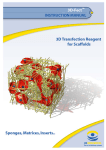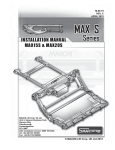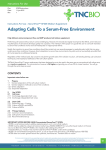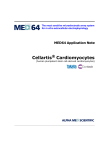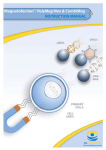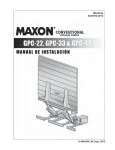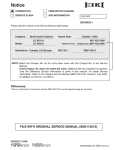Download OZ Biosciences / Protocol 3D-FectIN™ / vs. 1.6 / www.ozbiosciences
Transcript
OZ Biosciences / Protocol 3D-FectIN™ / vs. 1.6 / www.ozbiosciences.com / -0- 3D-FectIN™ Instruction Manual 3D-FectIN™ transfection reagent 3D Transfection: a novel perspective for your cell culture!! 3D-FectIN™ is the latest OZ Biosciences reagent for 3D transfection in hydrogel. It has been specifically designed and developed for transfection of cells cultured in 3D hydrogels (collagen, hyaluronic acid, PEG, laminin…). This reagent is based on a novel technology that allows adding a third dimension to cell cultures. List of 3D-FectIN™ Kits Catalog Number TN30250 TN30500 TN31000 Description Volume (µL) 3D-Fectin ™ 3D-Fectin ™ 3D-Fectin ™ 250 500 1000 Size (number of transfection / µg of DNA) 65 - 125 125 - 250 250 - 500 Use the content of the table above to determine the appropriate catalog number for your needs. You can order these products by contacting us (telephone, fax, mail, e-mail) or directly through our website. For all other supplementary information, do not hesitate to contact our dedicated technical support: [email protected]. OZ Biosciences Parc Scientifique de Luminy Zone Luminy Entreprise Case 922 13288 Marseille Cedex 9 - FRANCE. http://www.ozbiosciences.com Tel: +33 (0)4.86.94.85.16 Fax: +33 (0)4.86.94.85.15 E-mail: [email protected] Web Site: www.ozbiosciences.com OZ Biosciences / Protocol 3D-FectIN™ / vs. 1.6 / www.ozbiosciences.com / -1- Table of Contents 1. Technology 1.1. Description 1.2. Kit Contents 2. Applications 2.1. Application Areas 2.2. Cell Types 3. General Protocols 3.1. General Considerations 3.2. Cell Preparation 3.3. Protocol for Hydrogels 3.4. Optimization Protocol 4. Appendix 4.1. Quality Controls 4.2. Troubleshooting 5. Related Products 6. Purchaser Notification 2 2 2 3 3 3 3-6 3 3 4 5-6 7-8 7 7-8 9 10 1. Technology 1.1. Description Congratulations on your purchase of our latest 3D-FectIN™ transfection reagent! 3D-FectIN™ is the newest transfection reagents specifically designed and developed for In-Gel (or hydrogel) 3D cell cultures. 3D matrices not only add a third dimension to cells’ environment, they also allow creating significant differences in cellular characteristics and behavior. Because 3D environments are routinely used in basic research and therapeutic applications, OZ Biosciences has developed two new powerful reagents, 3DFectIN™ (for hydrogel) and 3DFect (for scaffolds). In this way, 3D matrices (Gels or Hydrogels) bearing complexes formed with 3D-FectIN™ reagent are colonized by cells to be transfected in a more natural environment. 3D-FectIN™ reagent associated with 3D matrices allows numerous cell transfections in order to follow angiogenesis, tube and acini formation, colonization, neurite growth, tissue engineering, tissue regeneration, tumor invasion, neural differentiation, cellular polarization, tissue formation… Principal 3D-Fectin ™ advantages: 1. Highly efficient 2. Ideal for any Gel and Hydrogel 3. Completely biodegradable 4. Universal (primary cells and cell lines) 5. Multipurpose (various types of nucleic acid) 6. Simple, ready-to-use & rapid 7. Serum compatible 8. Appropriate for multiple applications 9. Long term transgene expression 1.2. Kit Content OZ Biosciences offers two sizes of 3D-Fectin ™ transfection reagent. • One tube containing 250 µL of 3D-Fect ™ good for 65 to 125 transfections with 1 µg of DNA • One tube containing 500 µL of 3D-Fect ™ good for 125 to 250 transfections with 1 µg of DNA • One tube containing 1 mL of 3D-Fect ™ good for 250 to 500 transfections with 1 µg of DNA Stability and Storage Storage: Upon reception and for long-term use, store the reagent at -20°C for 3D-FectIN™. 3D-FectIN™ is stable for at least one year at room temperature, +4°C or -20°C. The storage at -20°C boosts the reagent efficiency and thus is preferred. Nonetheless, the reagent can also be stored at +4°C for shorter period of time. The numbers of freeze and thaw cycles do not affect the efficiency of the reagent. Shipping condition: Room Temperature. OZ Biosciences / Protocol 3D-FectIN™ / vs. 1.6 / www.ozbiosciences.com / -2- 2. Applications 2.1. Application Areas 3D-FectIN™ reagent has been developed for efficient transfections of nucleic acids into a wide variety of immortalized and primary cells. This transfection reagent is serum compatible and can be used for transient and stable transfection. This product is very stable, ready-to-use and intended for research purpose only. The field of applications covers angiogenesis, tube and acini formation, colonization, neurite growth, tissue engineering, tissue regeneration, tumor invasion, neural differentiation, wound healing, cellular polarization, tissue formation… 2.2. Cell Types 3D-FectIN™ transfection reagent is suitable for numerous cell types. It has been successfully tested on a variety of immortalized and primary cells (see results file). An updated list of transfected cells is available on OZ Biosciences website: www.ozbiosciences.com. You can also submit your data to [email protected] so we can update this list and give you all the support you need. 3. General Protocols 3.1. General Considerations The instructions given below represent sample protocols that were applied successfully to a variety of cells. Optimal conditions vary depending on the nucleic acid, cell types, hydrogel types, and cell culture conditions. Therefore, the amounts and ratio of the individual components (DNA and 3D-FectIN™) may have to be adjusted to achieve best results. Accordingly, we suggest you to optimize the various transfection parameters as described in section 3.4). The following recommendations can be used as guidelines to quickly achieve very good transfection efficiency. As a starting point, we recommend to use 2 to 4 µL of 3D-FectIN™ Reagent / 1 µg of DNA. 3D-FectIN™ can be used in the presence or in the absence of serum. You can use your routine culture medium for the transfection, except during preparation of the 3D-FectIN / DNA complexes (see 3.3 below). • Cells should be healthy and assayed during their exponential growing phase. The presence of contaminants (mycoplasma, fungi) will considerably affect the transfection efficiency. The cell proliferating rate is a critical parameter and the optimal confluency has to be adjusted according to the cells used. We recommend using regularly passaged cells for transfection and avoid employing cells that have been cultured for too long (> 2 months). • Nucleic acids should be as pure as possible. Endotoxins levels must be very low since they interfere with transfection efficiencies. Moreover, we suggest avoiding long incubation time of the DNA/RNA solution in buffers or serum free medium before the addition of 3D-FectIN™ reagent to circumvent any degradation or surface adsorption. • Antibiotics. The exclusion of antibiotics from the media during transfection has been reported to enhance gene expression levels. We did not observe a significant effect of the presence or absence of antibiotics with 3D-FectIN™ reagent and this effect is cell type dependent and usually small. • Materials. We recommend using polypropylene tubes to prepare the DNA and transfection reagent solutions but glass or polystyrene tubes can also be used. A protocol used for other transfection reagents should never be employed for 3D-FectIN™ and inversely. Each transfection reagent has its own molecular structure, biophysical properties and concentration, which have an important influence on their biological activity. 3.2. Cells Preparation It is recommended to seed the hydrogels on the day of transfection. 3D hydrogels. The suitable cell density will depend on the growth rate, size, ability to invade hydrogels and the cells conditions. Moreover each hydrogel bears specific characteristics regarding the cell type to be used. The correct choice of optimal plating density also depends on the planned time between transfection and OZ Biosciences / Protocol 3D-FectIN™ / vs. 1.6 / www.ozbiosciences.com / -3- transgene analysis: for a large interval, prefer lower density and for a short interval a higher density may be advantageous (see section 3.3 for procedure). Table 1: Cell number, DNA amount, 3D-FectIN™ volume and transfection conditions suggested for Hydrogels. Total Hydrogel Volume 50 µL 100 µL 200 µL Adherent Cell Number 0.1 – 0.5 x 10 5 0.5 – 2 x 10 5 1 – 4 x 10 5 DNA (µg) 2 4 8 3D-Fectin ™ Volume (µL) 4-8 8 - 16 16 - 32 Dilution Volume (µL) 2 x 12.5 2 x 25 2 x 50 Hydrogel volume (µL) 25 50 100 3.3. Protocol for Hydrogels Generally, gels must be diluted 50/50 volume with DNA/3D-FectIN complexes. A 50% dilution should be compatible with polymerization capacities of gels and shouldn’t interfere with cell growth. Before transfection experiments, we recommend testing cell culture on a 50% gel dilution with medium. Otherwise, we suggest reducing the dilution volume for the preparation of the DNA/3D-FectIN complexes. The DNA and 3D-FectIN™ solutions should have an ambient temperature and be gently vortexed prior to use. The rapid protocol is as simple as follows: Use 2 to 4 µL of 3D-FectIN™ per µg of DNA. We suggest beginning with these ratios (2, 3 and 4) and optimize it, if required, by following section 3.4. Important considerations before beginning transfection: • • 3D-FectIN™ must be stored at -20°C. If transfections are performed routinely, the transfection reagent can be kept at 4°C for one week after thawing. Thereafter, the reagent should be stored back at -20°C. Do not use serum-containing media for the preparation of DNA/3D-Fectin complexes (step 1)!! OZ Biosciences / Protocol 3D-FectIN™ / vs. 1.6 / www.ozbiosciences.com / -4- • • Prevent the 3D-FectIN™ and DNA stock solutions to come into contact with any plastic surface. First, add serum-free culture medium to the tube and then drop the 3D-FectIN™ and DNA stock solution directly into the medium. Contact of 3D-FectIN™ and DNA with the tube surface (plastic or glass) will result in materials lost by adsorption. For thermo-sensitive gels (i.e. MatrigelTM *, BD Biosciences) work on ice with 4°C cooled pipet tips for mixing complexes and gels (step 3) to keep gel in its liquid, non polymerized form for better complexes dispersion. 1) Preparation of DNA/3D-Fectin complexes 3D-Fectin / DNA complexes are prepared in PBS or medium without serum because serum interferes with vector assembly. − DNA solution. Dilute 2 to 8 µg of DNA in 12.5 to 50 µL of PBS or culture medium without serum and antibiotics as indicated in Table 1. For optimization see section 3.4. − 3D-Fectin ™ solution. Thaw the reagent at room temperature (the reagent can be warm in your hands for faster thawing). Dilute 4 to 32 µL of 3D-Fect ™ in 12.5 to 50 µL of PBS or culture medium without serum and antibiotics as indicated in Table 1. For optimization see section 3.4. − Add the DNA solution into the 3D-Fectin ™ solution, mix gently by carefully pipetting up and down 2-3 times. Do not vortex or centrifuge! 2) Incubate the mixture for 20 minutes at room temperature. 3) Mix the complexes with 25 to 100 µL of hydrogel. Avoid bubbles while dispersing complexes within the hydrogel. This step is crucial since complexes dispersion should be done rapidly (to keep liquid hydrogel) while avoiding bubbles that could interfere with transfection. 4) Dispatch these complexes-containing hydrogel in suitable culture dish or well and incubate at 37°C for 30 minutes for gel polymerization. 5) Add cells in complete medium on the gel. Gently rock the plate to homogenize cell suspension. 6) Let the cells colonize the hydrogel and incubate them at 37°C in a CO2 incubator under standard conditions until evaluation of the transgene expression. Depending on the cell type and promoter activity, the assay for the reporter gene can be performed 1 to several days following transfection. 3.4. Optimization Protocol Although high transfection efficiencies can be achieved in a broad range of cells and hydrogels with the rapid protocol, optimal conditions may vary depending on the nucleic acid, cell type, 3D gel composition and complexity, 3D hydrogel volume and culture medium composition. Therefore, we recommend optimizing the conditions for each combination of plasmid, cells and gel in order to get the best out of 3D-FectIN™ reagent. Several parameters can be optimized: • Ratio of 3D-FectIN to DNA • The quantity of nucleic acid used • Cell density • Culture medium composition (+/- serum) and reagent / nucleic acid complex medium • Incubation time We recommend that you optimize one parameter at a time while keeping the other parameters constant. The two most critical variables are the ratio of 3D-FectIN™ reagent to DNA and the quantity of DNA. 1) 3D-FectIN™ / DNA ratio: This is an important optimization parameter. Depending on the 3D gel, 3D-FectIN™ reagent has to be used in slight excess compare to DNA but the optimal ratio will also depend on the cells used. For example, in collagenbased gel we suggest the ratio 3D-Fectin / DNA of 4µL/µg DNA whereas for hyaluronic acid-based gel we recommend the ratio of 2/1. OZ Biosciences / Protocol 3D-FectIN™ / vs. 1.6 / www.ozbiosciences.com / -5- For optimization, first maintain a fixed quantity of DNA (according to the volume of the hydrogel and cell number) and then vary the amount of 3D-FectIN™ over the suggested range in the table 2. You can test ratios from 0.5 to 6 µl of 3D-FectIN™ reagents per 1 µg DNA. Table 2: Suggested range of 3D-FectIN™ for 3D-Fectin / DNA ratio optimization. Total Hydrogel Volume DNA 3D-Fectin ™ 3D-Fectin ™ Volume (µg) Volume (µL) (µL) proposed interval 50 µL 2 2 – 10 2 – 4 – 6 – 8 – 10 100 µL 4 4 – 20 4 – 8 – 12 – 16 – 20 200 µL 8 8 – 40 8 – 16 – 24 – 32 – 40 2) Quantity of DNA: After optimization of the 3D-Fectin / DNA ratio, proceed to adjust the best amount of DNA by maintaining a fixed ratio of 3D-Fectin to DNA, and vary the DNA quantity over the suggested range (Table 3). Table 3: Suggested range of DNA amounts for optimization with 3D-FectIN™. Total Hydrogel Volume DNA DNA quantity (µg) (µg) proposed interval 50 µL 1-4 1–2–3–4 100 µL 2-8 2–4–6–8 200 µL 4-16 4 – 8 – 12 – 16 Thereafter, culture medium compositions, cell number, incubation times can also be optimized. 3) Cell number: The cell proliferating rate is also a critical parameter and the optimal confluency has to be adjusted according to the cells used. Thus, the next step is to use the optimized ratio and DNA amount obtained previously and vary the cell number to be assayed. 4) 3D-FectIN™ / Nucleic acid complex medium: The buffer or medium composition use to prepare the 3D-Fectin / DNA may influence the transfection efficiency. For instance, PBS can be used to prepare the DNA and 3D-Fect ™ solutions instead of serum-free medium PBS composition: 137mM NaCl, 2.7mM KCl, 1.5mM KH2PO4 and 6.5mM Na2HPO4 x 2 H2O; pH7.4. Other buffers such as HBS, Tris can also be used. 5) Effect of serum /Transfection volume: Almost all cells transfected with 3D-FectIN™, showed good results if serum is present during the transfection. Some cell lines may behave differently and transfection efficiency can be increased without serum or under reduced serum condition. Remember that presence of serum during complex formation must be avoided. Transfection efficiency is delayed since cells have to colonize 3D matrices before transfection can occur. Consequently, the cells may be kept in serum-free or reduced serum conditions during the first 3 to 4 hours of transfection. If you use serum-free medium, replace it by a culture medium containing serum or just add serum to the wells according to your standard culture condition after this period. 6) Incubation time: The optimal time range between transfection and assay for gene activity varies with cell line, promoter activity, expression product, etc. The transfection efficiency can be monitored after 1 to several days. Reporter genes such as GFP, β-galactosidase, secreted alkaline phosphatase or luciferase can be used to quantitatively measured gene expression. These control plasmids completely compatible and successfully tested with 3DFectIN™ reagents are available at www.ozbiosciences.com (pVectOZ- GFP/LacZ/Luc/SEAP/CAT). OZ Biosciences team has developed a detailed protocol for optimization and also cell specific optimal transfection procedures. Thus, do not hesitate to contact our technical service at [email protected] to request these specific protocols. OZ Biosciences / Protocol 3D-FectIN™ / vs. 1.6 / www.ozbiosciences.com / -6- 4. Appendix 4.1 Quality Controls To assure the performance of each lot of 3D-Fectin ™ produced, we qualify each component using rigorous standards. The following in vitro assays are conducted to qualify the function, quality and activity of each kit component. Specification Standard Quality Controls Purity Silica Gel TLC assays. Every compound shall have a single spot. Sterility Thioglycolate assay. Absence of fungal and bacterial contamination shall be obtained for 7 days. Biological Activity Transfection efficacies on HEK-293 and COS-7 cells. Every lot shall have an acceptance specification of > 90% of the activity of the reference lot. 4.2. Troubleshooting Problems Low transfection efficiency Comments and Suggestions 1- 3D-FectIN™ / nucleic acid ratio. Optimize the reagent / DNA ratio by using a fixed amount of DNA (µg) and vary the amount of 3D-FectIN™ from 2 times less up to 2.5 times more than the suggested amount detailed in the Table 2. 2- Hydrogel / Dilution rate. The protocol is design for a 2X dilution of gel. Try reducing the volume of DNA/3D-FectIN™ mix to change final gel dilution. 3- DNA amount. Use different quantity of DNA with the recommended or optimized (above) 3D-Fectin / DNA ratio. 4- Cell density. A non-optimal cell density at the time of transfection can lead to insufficient uptake. Optimal cell density is difficult to assess since a third dimension is added in cell culture, try several densities depending on the support. 5- DNA quality. Nucleic acids should be as pure as possible and free of contaminants (proteins, phenol, ethanol etc.). Endotoxins levels must be very low since they interfere with transfection efficiencies. Employ nuclease-free materials. 6- Type of promoter. Ensure that DNA promoter can be recognized by the cells to be transfected. Other cells or viral-driven reporter gene expression can be used as a control. Low transfection efficiency 7- Cell condition. 1) Cells that have been in culture for a long time (> 8 weeks) may become resistant to transfection. Use freshly thawed cells that have been passaged at least once. 2) Cells should be healthy and assayed during their exponential growing phase. The presence of contaminants (mycoplasma, fungi) alters considerably the transfection efficiency. 8- Medium used for preparing DNA / 3D-Fectin complexes. It is critical that serum-free medium or buffer (HBS, PBS) are used during the preparation of the complexes. Avoid any direct contact of pure 3D-FectIN™ and pure DNA solution with the plastic surface. 9- Cell culture medium composition. 1) For some cells, transfection efficiency can be increased without serum or under reduced serum condition. Thus, transfect these cells in serum-free medium during the first 12h of incubation. 2) The presence of antibiotics might affect cell health and transfection efficiency. 10- Incubation time and transfection volume. The optimal time range between transfection and assay varies with cells, promoter, expression product, etc. The transfection efficiency can be monitored after 1 day. Several reporter genes can be used to quantitatively monitored gene expression kinetics. 11- Old 3D-Fectin / DNA complexes. The 3D-Fectin / DNA complexes must be freshly prepared every time. Complexes prepared and stored for longer than 1h can be aggregated. OZ Biosciences / Protocol 3D-FectIN™ / vs. 1.6 / www.ozbiosciences.com / -7- 12- Transgene detection assay. Ensure that your post-transfection assay is properly set up and includes a positive control. 13- 3D-Fectin reagent temperature. Reagents should have an ambient temperature and be vortexed prior to use. Cellular toxicity 14- Transfection reagent storage. Transfection efficiency can slowly decrease if 3DFectIN™ is kept more than one week at +4°C. Store at -20°C to recover initial efficiency. 1- Unhealthy cells. 1) Check cells for contamination, 2) Use new batch of cells, 3) Ensure culture medium conditions (pH, type of medium used, contamination etc), 4) Cells are too confluent or cell density is too low, 5) Verify equipments and materials. 2- Matrix Composition. Ensure that Matrices are compatible with the cells: depending on their compositions, 3D gel will allow cell to attach or not; non adhered cells can go on apoptosis. 3- Transgene product is toxic. Use suitable controls such as cells alone, transfection reagent alone or mock transfection with a DNA control. 4- DNA quality - Presence of contaminants. Ensure that nucleic acid is pure, contaminant-free and endotoxin-free. Use high quality nucleic acids as impurities can lead to cell death. 5- Concentration of transfection reagent / nucleic acid too high. Decrease the amount of nucleic acid / reagent complexes added to the cells by lowering the nucleic acid amount or the transfection reagent concentration. Complexes aggregation can cause some toxicity; prepare them freshly and adjust the ratio as outlined previously. 6- Incubation time. Reduce the incubation time of complexes with the cells by replacing the transfection medium by fresh medium after 4h to 24h. Our dedicated and specialized technical support group will be pleased to answer any of your requests and to help you with your transfection experiments. [email protected]. In addition, do not hesitate to visit our website www.ozbiosciences.com and the FAQ section. * MatrigelTM is a trademark own by BD Biosciences. OZ Biosciences / Protocol 3D-FectIN™ / vs. 1.6 / www.ozbiosciences.com / -8- 5. Related Products Description Reference 3D-Fection Technology 3D-Fect (for all 3D scaffolds : sponges, matrices, inserts…) Magnetofection Technology Mega Magnetic Plate Super Magnetic Plate Magnetic Plate 96-magnets PolyMag 1mL (for all nucleic acids) PolyMag Neo 1mL (for all nucleic acids) LipoMag Kit (for all nucleic acids) CombiMag 1mL (to boost transfection reagent) SilenceMag 1mL (for siRNA application) NeuroMag 1mL (for transfection of neurons) ViroMag 1mL (for all viral applications) ViroMag R/L 1mL (for retrovirus and Lentivirus) AdenoMag 1mL (for adenovirus) SelfMag Amino Kit SelfMag Carboxy Kit FluoMag-P 100µL FluoMag-C 100µL FluoMag-S 100µL FluoMag-V 100µL MF14000 MF10000 MF10096 PN31000 PG61000 LM80500 CM21000 SM11000 NM51000 VM41000 RL41000 AM71000 SA10000 SC20000 FP10100 FC10100 FS10100 FV10100 Protein Delivery Systems Ab-DeliverIN 1 mL Pro-DeliverIN 1 mL AI21000 PI11000 Lipofection Technology (lipid-based) Lullaby siRNA transfection reagent 1mL DreamFect Gold Transfection reagent 1mL DreamFect Transfection reagent 1mL EcoTransfect Transfection Reagent 1mL VeroFect Transfection Reagent 1mL FlyFectin Transfection Reagent 1mL LL71000 DG81000 DF41000 ET11000 VF61000 FF51000 CaPO Transfection Kit CP90000 Plasmids pVectOZ pVectOZ-CAT 25µg pVectOZ-GFP 25µg pVectOZ-LacZ 25µg pVectOZ-Luc 25µg pVectOZ-SEAP 25µg PL00010 PL00020 PL00030 PL00040 PL00050 Gene & Protein Tools Bradford – Protein Assay Kit GeneBlaster selection kit GeneBlaster Emerald β-Galactosidase (ONPG) assay kits β-Galactosidase (CPRG) assay kits X-Gal Staining Kit BA00100 GB20010 GB20014 GO10001 GC10002 GX10003 Biochemical D-Luciferin, Na+ 1g D-Luciferin, K+ 1g G-418, Sulfate 1g X-Gal powder 1g LN10000 LK10000 GS21000 XG11000 TF20250 Our dedicated and specialized technical support group will be pleased to answer any of your request and to assist you in your experiments. Do not hesitate to contact us for all complementary information and remember to visit our website in order to stay inform on our last breakthrough technologies and updated on our complete product list. http://www.ozbiosciences.com. OZ Biosciences / Protocol 3D-FectIN™ / vs. 1.6 / www.ozbiosciences.com / -9- Purchaser Notification Limited License The purchase of the 3D-FectIN™ Reagent grants the purchaser a non-transferable, non-exclusive license to use the kit and/or its separate and included components (as listed in section 1, Kit Contents). This reagent is intended for in-house research only by the buyer. Such use is limited to the transfection of nucleic acids as described in the product manual. In addition, research only use means that this kit and all of its contents are excluded, without limitation, from resale, repackaging, or use for the making or selling of any commercial product or service without the written approval of OZ Biosciences. Separate licenses are available from OZ Biosciences for the express purpose of non-research use or applications of the 3D-FectIN™ Reagent. To inquire about such licenses, or to obtain authorization to transfer or use the enclosed material, contact the Director of Business Development at OZ Biosciences. Buyers may end this License at any time by returning all 3D-FectIN™ Reagent material and documentation to OZ Biosciences, or by destroying all 3D-FectIN™ components. Purchasers are advised to contact OZ Biosciences with the notification that a 3D-FectIN™ kit is being returned in order to be reimbursed and/or to definitely terminate a license for internal research use only granted through the purchase of the kit(s). This document covers entirely the terms of the 3D-FectIN™ Reagent research only license, and does not grant any other express or implied license. The laws of the French Government shall govern the interpretation and enforcement of the terms of this License. Product Use Limitations The 3D-FectIN™ Reagent and all of its components are developed, designed, intended, and sold for research use only. They are not to be used for human diagnostic or included/used in any drug intended for human use. All care and attention should be exercised in the use of the kit components by following proper research laboratory practices. For more information, or for any comments on the terms and conditions of this License, please contact: Director of Business Development OZ Biosciences Parc Scientifique de Luminy Zone Luminy Entreprise 163, avenue de Luminy – Case 922 13288 Marseille Cedex 9 - FRANCE Tel: +33 (0)4. .86.94.85.16 Fax: +33 (0)4. .86.94.85.15 E-mail: [email protected] OZ Biosciences / Protocol 3D-FectIN™ / vs. 1.6 / www.ozbiosciences.com / - 10 -











